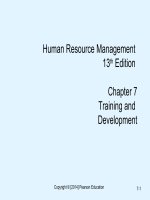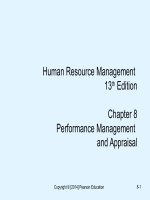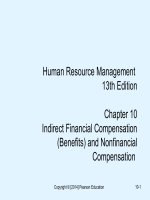Human resource 1e by denisi griffin chapter 12
Bạn đang xem bản rút gọn của tài liệu. Xem và tải ngay bản đầy đủ của tài liệu tại đây (829.63 KB, 15 trang )
Prepared by Joseph B. Mosca, Monmouth University and
© 2012 South-Western, Cengage Learning, Inc.
All rights reserved.
Marla M. Kameny, Baton Rouge Community College
PowerPoint Presentation Design by Charlie Cook
The University of West Alabama
Learning Objectives
After studying this chapter, you should be able to:
1. Identify and discuss the central elements associated with
employee safety and health
2. Discuss issues involved in the physical work environment
3. Discuss health- and stress-management in organizations
4. Identify and describe the most important HR-related
security issues in organizations
© 2012 South-Western, Cengage Learning, Inc. All rights reserved.
12–2
Employee Safety and Health
• Safety Hazards
Conditions in the work environment that have
the potential to cause harm to an employee
• Health Hazards
Characteristics of the work environment that
slowly, systematically, and cumulatively, result
in damage to employee health
© 2012 South-Western, Cengage Learning, Inc. All rights reserved.
12–3
Most Dangerous Occupations in the United States,
2008
© 2012 South-Western, Cengage Learning, Inc. All rights reserved.
12–4
Workplace Safety and Health
Legislation
• Occupational Safety and Health Act
Authorized the U.S. government to create and
enforce various standards regarding occupational
safety and health.
Assigned to the Department of Labor.
The Department of Health sponsors research to
establish criteria for various tasks and occupations
and for training in employee compliance.
© 2012 South-Western, Cengage Learning, Inc. All rights reserved.
12–5
Sample General Industry Safety and Health
Regulations from OSHA
© 2012 South-Western, Cengage Learning, Inc. All rights reserved.
12–6
Beyond the Book:
Major Categories of Occupational Illnesses
Occupational skin diseases or disorders
Dust diseases of the lungs
Respiratory conditions due to toxic agents
Poisoning
Disorders due to physical agents
Disorders associated with repeated trauma
Other categories of occupational illness
© 2012 South-Western, Cengage Learning, Inc. All rights reserved.
12–7
Safety at Work
• Controlling Accidents At Work
Safety engineers
Employee training
• Controlling Occupational Diseases
Organizations should be thoroughly
familiar with hazardous
circumstances in the work
environment that might cause
occupational diseases.
© 2012 South-Western, Cengage Learning, Inc. All rights reserved.
12–8
The Physical Environment
at Work
Temperature
Lighting
Background music
Hours of work
Circadian rhythms
© 2012 South-Western, Cengage Learning, Inc. All rights reserved.
12–9
Stress at Work
• Stress
A person’s adaptive response to a stimulus
that places excessive psychological or
physical demands on him or her.
• Stress and Personality Types
Type A Personality
Type B Personality
Hardiness
© 2012 South-Western, Cengage Learning, Inc. All rights reserved.
12–10
The Causes and Consequences of Stress in
Organizations
© 2012 South-Western, Cengage Learning, Inc. All rights reserved.
12–11
Most and Least Stressful Jobs
© 2012 South-Western, Cengage Learning, Inc. All rights reserved.
12–12
Consequences of Stress at Work
• Burnout
• Turnover
• Dysfunctional Behavior
© 2012 South-Western, Cengage Learning, Inc. All rights reserved.
12–13
Promoting Wellness in
Organizations
• Institutional Programs
Attempt to manage stress through established
organizational mechanisms.
• Collateral Stress Programs
Are organizational programs created to help
employees deal with stress.
• Other Program Interventions
H1N1
AIDS
© 2012 South-Western, Cengage Learning, Inc. All rights reserved.
12–14
Workplace Security
• Employees need to feel
safe from:
Bombings
Kidnappings
Terrorists
• U.S. firms are engaging
in high-level emergency
preparedness
© 2012 South-Western, Cengage Learning, Inc. All rights reserved.
12–15









